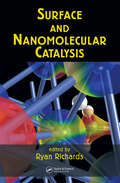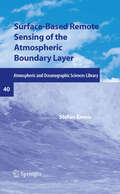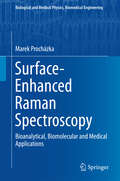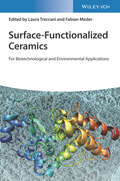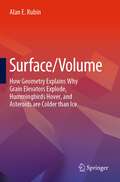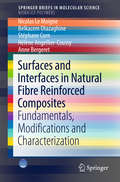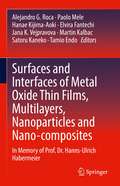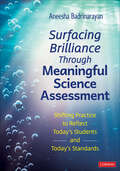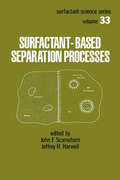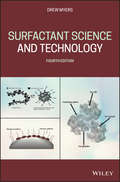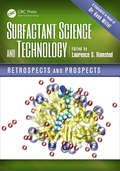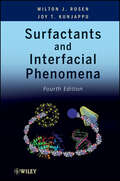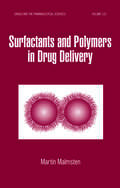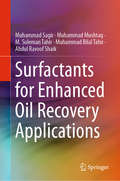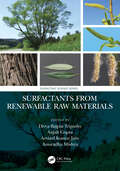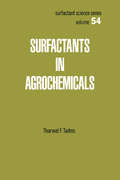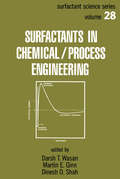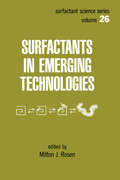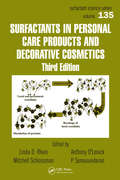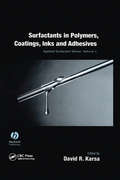- Table View
- List View
Surface and Nanomolecular Catalysis
by Ryan RichardsUsing new instrumentation and experimental techniques that allow scientists to observe chemical reactions and molecular properties at the nanoscale, the authors of Surface and Nanomolecular Catalysis reveal new insights into the surface chemistry of catalysts and the reaction mechanisms that actually occur at a molecular level during catalys
Surface and Tip-Enhanced Raman Scattering Spectroscopy: Bridging Theory and Applications
by Yukihiro Ozaki Marek Procházka Janina Kneipp Bing ZhaoThis book describes recent progress in the mechanistic studies and applications of surface-enhanced Raman scattering (SERS) and tip-enhanced Raman scattering (TERS). In this book, various novel techniques in SERS and TERS such as UV resonance TERS, electrochemical TERS, and three-dimensional SERS imaging are outlined. A number of new applications of SERS and TERS such as those to photonics, nanotechnology, microfluidics, and medical diagnosis along with future perspectives are also discussed. Finally, the applications of new data analysis, models, and machine learning in SERS and TERS studies are reviewed. The novelty of this book is the forming of a new bridge between the theory and applications. Also, the importance of chemical mechanism and that of semiconductor-enhanced Raman scattering is emphasized. The main audiences are researchers in academia, research institutes, companies, and graduate students looking for a comprehensive book on the latest studies of SERS and TERS.
Surface-Based Remote Sensing of the Atmospheric Boundary Layer
by Stefan EmeisThe book presents a comprehensive overview of the current state-of-the-art in the atmospheric boundary layer (ABL) research. It focuses on experimental ABL research, while most of the books on ABL discuss it from a theoretical or fluid dynamics point of view. Experimental ABL research has been made so far by surface-based in-situ experimentation (tower measurements up to a few hundred meters, surface energy balance measurements, short aircraft experiments, short experiments with tethered balloons, constant-level balloons, evaluation of radiosonde data). Surface flux measurements are also discussed in the book. Although the surface fluxes are one of the main driving factors for the daily variation of the ABL, an ABL description is only complete if its vertical structure is analyzed and determined. Satellite information is available covering large areas, but it has only limited temporal resolution and lacks sufficient vertical resolution. Therefore, surface-based remote sensing is a large challenge to enlarge the database for ABL studies, as it offers nearly continuous and vertically highly resolved information for specific sites of interest. Considerable progress has been made in the recent years in studying of ground-based remote sensing of the ABL. The book discusses such new subjects as micro-rain radars and the use of ceilometers for ABL profiling, modern small wind lidars for wind energy applications, ABL flux profile measurements, RASS techniques, and mixing-layer height determination.
Surface-Enhanced Raman Spectroscopy
by Marek ProcházkaThis book gives an overview of recent developments in RS and SERS for sensing and biosensing considering also limitations, possibilities and prospects of this technique. Raman scattering (RS) is a widely used vibrational technique providing highly specific molecular spectral patterns. A severe limitation for the application of this spectroscopic technique lies in the low cross section of RS. Surface-enhanced Raman scattering (SERS) spectroscopy overcomes this problem by 6-11 orders of magnitude enhancement compared with the standard RS for molecules in the close vicinity of certain rough metal surfaces. Thus, SERS combines molecular fingerprint specificity with potential single-molecule sensitivity. Due to the recent development of new SERS-active substrates, labeling and derivatization chemistry as well as new instrumentations, SERS became a very promising tool for many varied applications, including bioanalytical studies and sensing. Both intrinsic and extrinsic SERS biosensing schemes have been employed to detect and identify small molecules, nucleic acids and proteins, and also for cellular and in vivo sensing.
Surface-Functionalized Ceramics: For Biotechnological and Environmental Applications
by Laura Treccani Fabian MederSurface-Functionalized Ceramics Focused coverage of making and using functional ceramic materials for a wide variety of scientific and technical applications Surface-Functionalized Ceramics provides a comprehensive overview of surface functionalization approaches for ceramic materials, including alumina, zirconia, titania, and silica, and their uses as sensors, chemical, and biological probes, chromatographic supports for (bio)molecule purification and analysis, and adsorbents for toxic substances and pollutants. Overall, the text provides a broad picture of the enormous possibilities offered by surface functionalization and addresses the current challenges regarding surface analysis, characterization, and stability. As a well-rounded resource, the text points out opportunities of surface-functionalized ceramics, their issues such as achieving surface stability and complex analysis, and how to counter them. Edited by two experts in the field of advanced materials surfaces, Surface-Functionalized Ceramics covers topics such as: Processing methods for advanced ceramics, surface modification of ceramic materials, and methods for electrokinetic surface characteristics Surface imaging and chemical surface analysis using atomic force microscopy Surface chemical analysis and ceramic-enhanced analytics Biological and living matter-surface interactions including protein adsorption mechanisms as well as bacteria behavior in terms of biofilm formation and prevention for antibacterial applications Mesoporous silica and organosilica biosensors for water quality and environmental monitoring, plus ceramic-based adsorbents in bioproduct recovery and purification For professionals, researchers, and academics in the fields of materials science, biotechnology, biotechnological industry, environmental sciences, and ceramics industry, Surface-Functionalized Ceramics is a one-stop reference on the subject that provides different approaches to obtain surfaces of ceramic materials that perform desired functions.
Surface/Volume: How Geometry Explains Why Grain Elevators Explode, Hummingbirds Hover, and Asteroids are Colder than Ice
by Alan E. RubinThis book explains that diffusion, osmosis, dissolution, evaporation, and heat loss all preferentially affect small bodies due to their high surface/volume ratios. Because surface area increases as the square of length, but volume (and mass) increase as the cube, large objects have low surface/volume ratios and small objects have high surface/volume ratios. This simple physical constraint governs much of the physical world. It accounts for why the Earth has active volcanoes, but the Moon does not, why the human brain has numerous folds, why deciduous trees lose their leaves every Fall, and why nanoparticles of gold melt at surprisingly low temperatures. It is a phenomenon well known to every scientist, but this book is the first comprehensive treatment of this effect.
Surfaces and Interfaces in Natural Fibre Reinforced Composites
by Nicolas Le Moigne Belkacem Otazaghine Stéphane Corn Hélène Angellier-Coussy Anne BergeretThis book is addressed to Master and PhD students as well as researchers from academia and industry. It aims to provide the key definitions to understand the issues related to interface modifications in natural fibre based composites considering the particular supramolecular and micro- structures encountered in plant fibres. A particular emphasis is given to the modification and functionalization strategies of natural fibres and their impact on biocomposites behaviour and properties. Commonly used and newly developed treatment processes are described in view of scaling-up natural fibre treatments for their implementation in industry. Finally, a detailed and comprehensive description of the tools and methodologies developed to investigate and characterize surfaces and interfaces in natural fibre based composites is reviewed and discussed.
Surfaces and Interfaces of Metal Oxide Thin Films, Multilayers, Nanoparticles and Nano-composites: In Memory of Prof. Dr. Hanns-Ulrich Habermeier
by Paolo Mele Tamio Endo Satoru Kaneko Alejandro G. Roca Hanae Kijima-Aoki Elvira Fantechi Jana K. Vejpravova Martin KalbacThis book provides a general overview and current state of the art of different types of metal oxide nanomaterials, either in nanoparticles or thin film structure. It covers from the development and optimization of different nanofabrication/synthesis techniques for nanostructures which are currently the attention of the research community, the study of the structure and interactions by different characterization techniques of heterostructured materials and the final impact in different applications such as nanotherapy, data storage, super magnets, high-frequency devices. The book’s 13 chapters provide deep insight into the intriguing science of oxide materials and include contributions on novel technologies to fabricate nanomaterials with a broad range of functional properties (semiconducting, magnetic, ferroelectric, thermoelectric, optical, flexible and mechanical). This book is intended to the experts for consolidation of their knowledge but also for students who aim to learn and get basics of nanostructured metal oxides in diverse forms.
Surfaces: A History
by Joseph A. AmatoHuman beings are surrounded by surfaces: from our skin to faces, to the walls and streets of our homes and cities, to the images, books, and screens of our cultures and civilizations, to the natural world and what we imagine beyond. In this thought-provoking and richly textured book, Joseph A. Amato traces the human relationship with surfaces from the deep history of human evolution, which unfolded across millennia, up to the contemporary world. Fusing his work on Dust and On Foot, he shows how, in the last two centuries, our understanding, creation, control, and manipulation of surfaces has become truly revolutionary--in both scale and volume. With the sweep of grand history matched to existential concerns for the present, he suggests that we have become the surfaces we have made, mastered, and now control, invent, design, and encapsulate our lives. This deeply informed and original narrative, which joins history and anthropology and suggests new routes for epistemology and aesthetics, argues that surfaces are far more than superficial façades of deep inner worlds.
Surfacing Brilliance Through Meaningful Science Assessment: Shifting Practice to Reflect Today′s Students and Today′s Standards
by Aneesha BadrinarayanScience education is evolving–and our assessments should, too. The Next Generation Science Standards and similar standards based on A Framework for K-12 Science Education ushered in a bold vision focused on figuring out phenomena and problems, sensemaking that mirrors how scientists work, and real-world relevance. Although instruction has started to shift, assessment has too often lagged behind—failing to capture or support the depth, complexity, and creativity of meaningful science learning. Surfacing Brilliance Through Meaningful Science Assessment: Shifting Practice to Reflect Today’s Students and Today’s Standards is the essential guide for educators and leaders ready to rethink how we understand, evaluate, and support K-12 science learning. Written by Aneesha Badrinarayan, a leading voice in science education and assessment, this book offers a clear roadmap for designing assessments that surface the brilliance of young people in ways that are meaningful, equitable, and grounded in the lived realities of today’s classrooms. Drawing on four core priorities—sensemaking, relevance, assets, and opportunity—this book empowers educators to move beyond traditional tests to create assessments that reveal what students truly understand and can do. Bridging cutting-edge research and practical implementation, this book offers: Concrete strategies for using phenomena, problematizing strategies, and purposeful prompts to drive authentic sensemaking Frameworks and tools to develop relevant, asset-based assessments that reflect students’ strengths and experiences and are specific to a given classroom context Approaches to using data for targeted feedback and deeper learning A forward-looking chapter on how to meaningfully integrate AI into science assessment in an age of rapidly evolving technology Whether you’re a K–12 teacher, instructional leader, or assessment designer, Surfacing Brilliance Through Meaningful Science Assessment will transform how you think about using assessment to understand, evaluate, and support student learning. This guide ensures that educators and leaders assess students in ways that center student brilliance, embrace innovation, and inspire learners to achieve ambitious learning goals in science.
Surfacing Brilliance Through Meaningful Science Assessment: Shifting Practice to Reflect Today′s Students and Today′s Standards
by Aneesha BadrinarayanScience education is evolving–and our assessments should, too. The Next Generation Science Standards and similar standards based on A Framework for K-12 Science Education ushered in a bold vision focused on figuring out phenomena and problems, sensemaking that mirrors how scientists work, and real-world relevance. Although instruction has started to shift, assessment has too often lagged behind—failing to capture or support the depth, complexity, and creativity of meaningful science learning. Surfacing Brilliance Through Meaningful Science Assessment: Shifting Practice to Reflect Today’s Students and Today’s Standards is the essential guide for educators and leaders ready to rethink how we understand, evaluate, and support K-12 science learning. Written by Aneesha Badrinarayan, a leading voice in science education and assessment, this book offers a clear roadmap for designing assessments that surface the brilliance of young people in ways that are meaningful, equitable, and grounded in the lived realities of today’s classrooms. Drawing on four core priorities—sensemaking, relevance, assets, and opportunity—this book empowers educators to move beyond traditional tests to create assessments that reveal what students truly understand and can do. Bridging cutting-edge research and practical implementation, this book offers: Concrete strategies for using phenomena, problematizing strategies, and purposeful prompts to drive authentic sensemaking Frameworks and tools to develop relevant, asset-based assessments that reflect students’ strengths and experiences and are specific to a given classroom context Approaches to using data for targeted feedback and deeper learning A forward-looking chapter on how to meaningfully integrate AI into science assessment in an age of rapidly evolving technology Whether you’re a K–12 teacher, instructional leader, or assessment designer, Surfacing Brilliance Through Meaningful Science Assessment will transform how you think about using assessment to understand, evaluate, and support student learning. This guide ensures that educators and leaders assess students in ways that center student brilliance, embrace innovation, and inspire learners to achieve ambitious learning goals in science.
Surfactant - Based Separation Processes
by John F. ScamehornFocuses on novel techniques and reviews established methods for surfactant-based separation processes that can be widely applied in industry. Describes new extraction techniques, micellar-enhanced ultrafiltration and admicellar chromatography, protein extraction using reverse micelles, surfactant-en
Surfactant Science and Technology
by Drew MyersA solid introduction to the field of surfactant science, this new edition provides updated information about surfactant uses, structures, and preparation, as well as seven new chapters expanding on technology applications. Offers a comprehensive introduction and reference of the science and technology of surface active materials Elaborates, more fully than prior editions, aspects of surfactant crystal structure as well as their effects on applications Adds more information on new classes and applications of natural surfactants in light of environmental consequences of surfactant use
Surfactant Science and Technology: Retrospects and Prospects
by Laurence S. RomstedSurfactant research explores the forces responsible for surfactant assembly and the critical industrial, medical, and personal applications, including viscosity control, microelectronics, drug stabilization, drug delivery, cosmetics, enhanced oil recovery, and foods. Surfactant Science and Technology: Retrospects and Prospects, "a Festschrift in ho
Surfactants and Interfacial Phenomena
by Milton J. Rosen Joy T. KunjappuNow in its fourth edition, Surfactants and Interfacial Phenomena explains why and how surfactants operate in interfacial processes (such as foaming, wetting, emulsion formation and detergency), and shows the correlations between a surfactant's chemical structure and its action. Updated and revised to include more modern information, along with additional three chapters on Surfactants in Biology and Biotechnology, Nanotechnology and Surfactants, and Molecular Modeling with Surfactant Systems, this is the premier text on the properties and applications of surfactants. This book provides an easy-to-read, user-friendly resource for industrial chemists and a text for classroom use, and is an unparalleled tool for understanding and applying the latest information on surfactants. Problems are included at the end of each chapter to enhance the reader's understanding, along with many tables of data that are not compiled elsewhere. Only the minimum mathematics is used in the explanation of topics to make it easy-to-understand and very user friendly.
Surfactants and Polymers in Drug Delivery (Drugs and the Pharmaceutical Sciences)
by Martin MalmstenThis reference features the latest findings surrounding the physicochemical aspects of surfactant and polymer systems to facilitate the design and understanding of novel and advanced drug delivery formulations. It covers the basics of surfactant and polymer surface activity and self-assembly, the various types of structures formed by such compounds
Surfactants for Enhanced Oil Recovery Applications
by Muhammad Sagir Muhammad Mushtaq M. Suleman Tahir Muhammad Bilal Tahir Abdul Ravoof ShaikThis book provides a concise treatise on the use of surfactants in enhanced oil recovery (EOR), including information on key types of surfactants and their respective applications in the wider petroleum industry. The authors discuss carbon dioxide EOR, alkaline-surfactant-polymer flooding strategies, and the use of surfactants as a means of reducing interfacial tension, while also paying special attention to the challenges involved in using surfactants for enhanced oil recovery, such as the difficult issue of surfactant adsorption on reservoir rock. All chapters highlight and are based on the authors’ own laboratory-scale case studies. Given its content, the book offers a valuable asset for graduate students of petroleum and chemical engineering, as well as researchers in the field of chemical enhanced oil recovery. It will also be of interest to professionals involved in enhanced industrial oil recovery.
Surfactants from Renewable Raw Materials (Surfactant Science)
by Anuradha Mishra Arvind Kumar Jain Divya Bajpai Tripathy Anjali GuptaSurfactants are often completely invisible to us and yet they are present in almost every chemical that we use in our daily life. They are found in toothpastes, cosmetics, sunscreens, mayonnaise, detergents, and an array of cleaning products. Traditional surfactants are known to have adverse environmental impacts spurring research into eco-friendly and cost-effective surfactants from renewable resources. Surfactants from Renewable Raw Materials examines the class of surfactants synthesized using plant-based raw materials detailing their properties, applications, bioavailability, and biodegradability. The concluding chapter reviews patent activity over the last decade. Additional features include: Addresses the tremendous variation found in the raw materials used to synthesize commercially available surfactants. Explores the selection of raw materials based upon the desired hydrophobic group or hydrophilic group to be incorporated into the product. Examines the characteristics and medicinal applications of pulmonary surfactants in preterm babies as well as their probable contribution in COVID-19 Discusses the biodegradability of surfactants to assist with the determination of truly green surfactants. This comprehensive reference will prove indispensable for professional and academic researchers creating or working with bio-based surfactants.
Surfactants in Agrochemicals (Surfactant Science Ser. #54)
by TharwatF. TadrosThis work highlights the physical chemistry of surfactant solutions, detailing a fundamental method of selecting surfactants for agrochemical formulations and delineating how surfactants enhance the biological efficacy of agrochemicals. The unique properties of surfactants that have a major influence on the performance of an agrochemical are summarized.;The book is intended for physical, surface and colloid chemists; biochemists; microbiologists; agronomists; research and development personnel in the pesticide and fertilizer industries; and upper-level undergraduate and graduate students taking chemistry and chemical engineering courses.;College and university bookstores may order five or more copies at a special price which is available on request from Marcel Dekker Inc.
Surfactants in Chemical/Process Engineering (Surfactant Science Ser. #28)
by WasanThe first reference to link chemical engineering technologies and surfactant science in suchbreadth of focus, Surfactants in Chemical/Process Engineering features contributionsby major authorities in chemical engineering whose applications have opened important newfields for surfactant use. These applications include dispersion science, separation processes, oilrecovery, microemulsions, and environmental control.This volume discusses ultrafiltration processes, flotation, metal extractions, and more ...examines surfactants in process streams for such industrial separations as micellar-enhancedultrafiltration, adsorbent regeneration, micellar extractions, and oiVwater demulsification . ..describes methodologies for separations of fatty acids, metals, minerals and impurities,solvents, and hydrocarbons for cost-saving industrial and consumer product manufacture . . .details techniques for developing and optimizing formulations for superior agricultural plantcontrol or enhancement systems, micro- and macroemulsions, and liquid surfactant membranes... and looks closely at emulsion polymers in soil stabilizations, protective coatings, sealants,adhesives, textile processing, paper finishing, specialty concretes, and tire manufacture.
Surfactants in Cosmetics (Surfactant Science #68)
by Martin M. Rieger Linda D. Rhein""Second Edition provides a thorough, up-to-date treatment of the fundamental behavior of surface active agents in solutions, their interaction with biological structures from proteins and membranes to the stratum corneum and epidermis, and their performance in formulations such as shampoos, dentifrice, aerosols, and skin cleansers.
Surfactants in Emerging Technology
by Milton J. RosenThis book is based on the proceedings of the conference "The role of surfactants in new and emerging technology". It examines the position of surfactants in the new growth areas, and describes the needs for surfactant research to facilitate advances in those areas.
Surfactants in Personal Care Products and Decorative Cosmetics (Surfactant Science)
by Linda D. Rhein P. Somasundaran Mitchell Schlossman Anthony O’LenickFrom anti-aging creams to make-up, surfactants play a key role as delivery systems for skin care and decorative cosmetic products. Surfactants in Personal Care Products and Decorative Cosmetics, Third Edition presents a scientific basis in surfactant science and recent advances in the industry necessary for understanding, formulating, and te
Surfactants in Polymers, Coatings, Inks, and Adhesives
by David R. KarsaSurface active agents are used as process aids in the production of polymers--as additives to impart or modify polymer properties--and in the formulation and further processing of polymeric systems for a variety of applications. In all these uses, the surfactants are used as 'effect chemicals,' to impart specific performance characteristics or properties to the base polymer or to enhance it performance when formulated for a specific end use.This volume focuses on those surfactant areas incorporating the greatest number of supplier and user companies. Authors have been selected from leading industrial and academic laboratories around the world. It provides an introduction to the underlying chemistry and technology in these industrial areas, and at the same time, highlights important recent developments.Surfactants in Polymers, Coatings, Inks and Adhesives is a book for surfactant researchers and for manufacturers and users of surfactants. In particular, surfactant chemists, analytical chemists, environmental chemists, users of surfactant formulations in the fields of specialty chemicals, polymers, and detergents, and health and safety personnel.
Surfactants in Solution (Surfactant Science Ser. #64)
by Arun K. Chattopadhyay; K. L. MittalContains selected invited papers presented at the 10th International Symposium on Surfactants in Solution held in Caracas, Venezuela. The volume covers phase behaviour of monolayers, contact angle hysteresis, micellar relaxation, micellar catalyzed reactions, polymerization in microemulsions, polymer-surfactant complexation, asphaltenes, and more.
